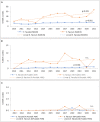Epidemiology of vancomycin-resistant enterococci in the United Arab Emirates: a retrospective analysis of 12 years of national AMR surveillance data
- PMID: 38089023
- PMCID: PMC10715431
- DOI: 10.3389/fpubh.2023.1275778
Epidemiology of vancomycin-resistant enterococci in the United Arab Emirates: a retrospective analysis of 12 years of national AMR surveillance data
Abstract
Introduction: Enterococci are usually low pathogenic, but can cause invasive disease under certain circumstances, including urinary tract infections, bacteremia, endocarditis, and meningitis, and are associated with peritonitis and intra-abdominal abscesses. Increasing resistance of enterococci to glycopeptides and fluoroquinolones, and high-level resistance to aminoglycosides is a concern. National antimicrobial resistance (AMR) surveillance data for enterococci from the Middle East and North Africa (MENA) and the Gulf region is scarce.
Methods: A retrospective 12-year analysis of N = 37,909 non-duplicate diagnostic Enterococcus spp. isolates from the United Arab Emirates (UAE) was conducted. Data was generated by routine patient care during 2010-2021, collected by trained personnel and reported by participating surveillance sites to the UAE National AMR Surveillance program. Data analysis was conducted with WHONET.
Results: Enterococcus faecalis was the most commonly reported species (81.5%), followed by Enterococcus faecium (8.5%), and other enterococci species (4.8%). Phenotypically vancomycin-resistant enterococci (VRE) were found in 1.8% of Enterococcus spp. isolates. Prevalence of VRE (%VRE) was highest for E. faecium (8.1%), followed by E. faecalis (0.9%). A significant level of resistance to glycopeptides (%VRE) for these two species has been observed in the majority of observed years [E. faecalis (0-2.2%), 2010: 0%, 2021: 0.6%] and E. faecium (0-14.2%, 2010: 0%, 2021: 5.8%). Resistance to fluoroquinolones was between 17 and 29% (E. faecalis) and was higher for E. faecium (between 42 and 83%). VRE were associated with higher patient mortality (RR: 2.97), admission to intensive care units (RR: 2.25), and increased length of stay (six excess inpatient days per VRE case), as compared to vancomycin-susceptible Enterococcus spp.
Discussion: Published data on Enterococcus infections, in particular VRE-infections, in the UAE and MENA region is scarce. Our data demonstrates that VRE-enterococci are relatively rare in the UAE, however showing an increasing resistance trend for several clinically important antibiotic classes, causing a concern for the treatment of serious infections caused by enterococci. This study also demonstrates that VRE were associated with higher mortality, increased intensive care unit admission rates, and longer hospitalization, thus poorer clinical outcome and higher associated costs in the UAE. We recommend the expansion of current surveillance techniques (e.g., local VRE screening), stricter infection prevention and control strategies, and better stewardship interventions. Further studies on the molecular epidemiology of enterococci are needed.
Keywords: United Arab Emirates (UAE); antimicrobial resistance (AMR); surveillance; vancomycin; vancomycin-resistant enterococci (VRE).
Copyright © 2023 Thomsen, Abdulrazzak, AlRand, The UAE AMR Surveillance Consortium, Menezes, Moubareck, Everett, Senok and Podbielski.
Conflict of interest statement
The authors declare that the research was conducted in the absence of any commercial or financial relationships that could be construed as a potential conflict of interest.
Figures








References
-
- Werner G, Abu Sin M, Bahrs C, Brogden S, Feßler AT, Hagel S, et al. Therapierelevante Antibiotikaresistenzen im One-Health-Kontext [Therapy-relevant antibiotic resistances in a One Health context]. Bundesgesundheitsblatt Gesundheitsforschung Gesundheitsschutz. (2023) 66:628–43. 10.1007/s00103-023-03713-4 - DOI - PMC - PubMed
Publication types
MeSH terms
Substances
LinkOut - more resources
Full Text Sources
Research Materials
Miscellaneous

